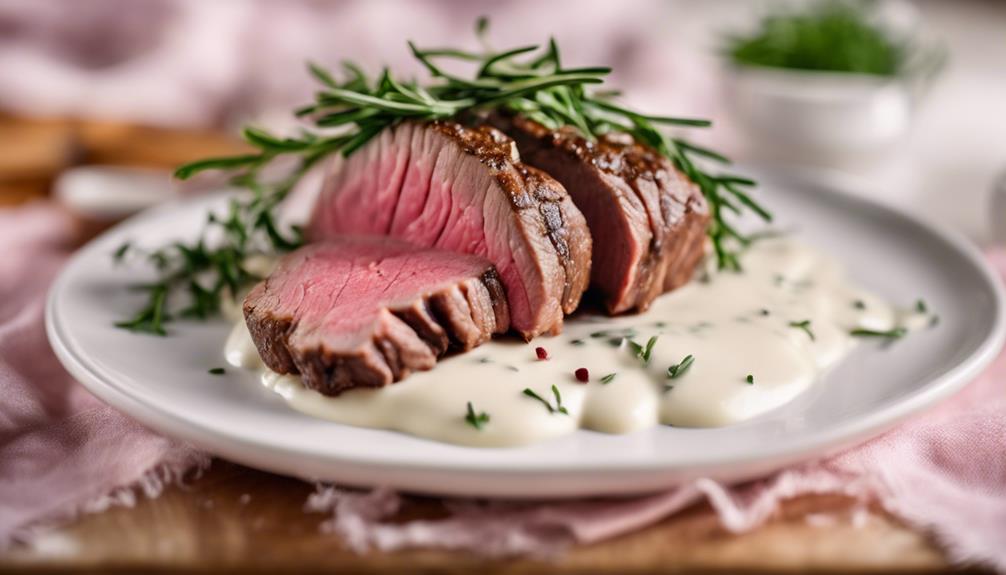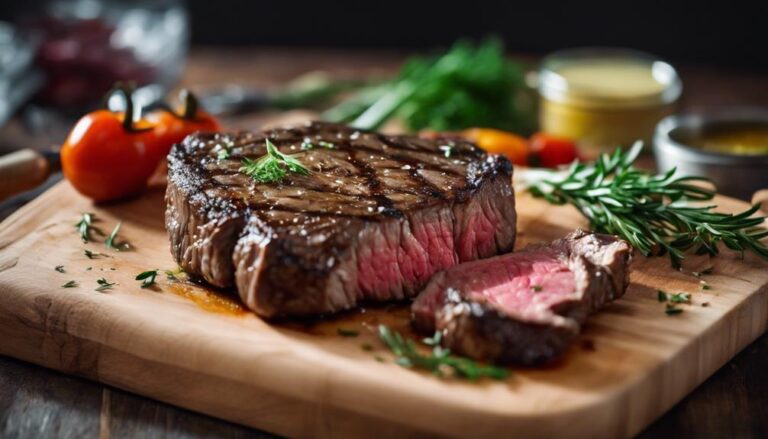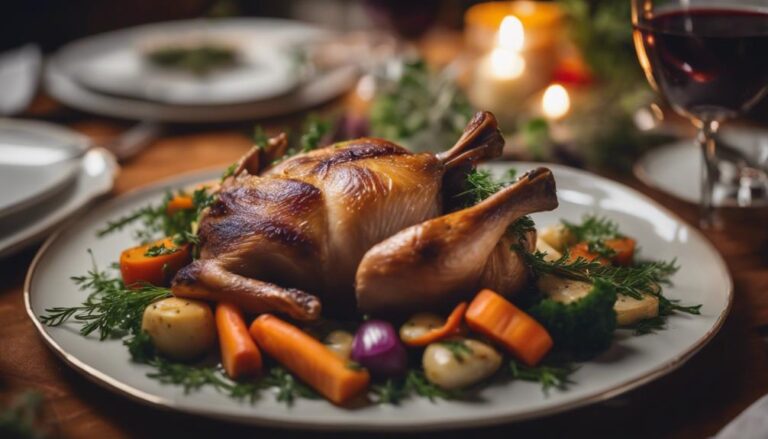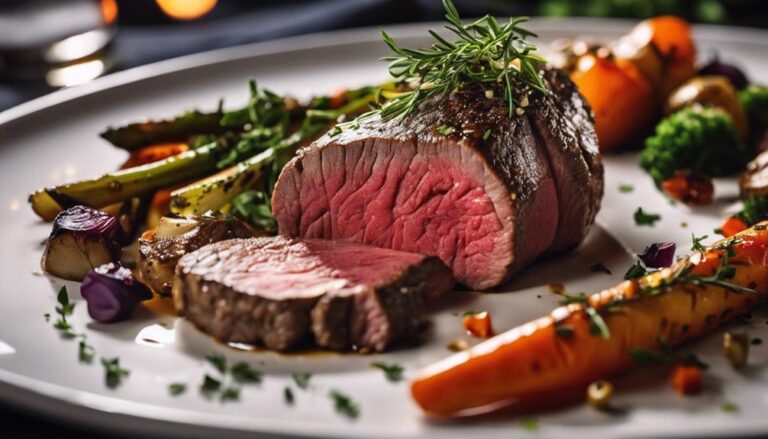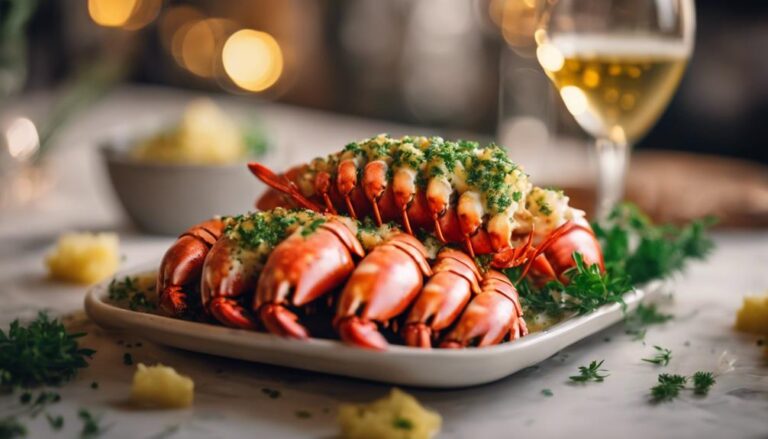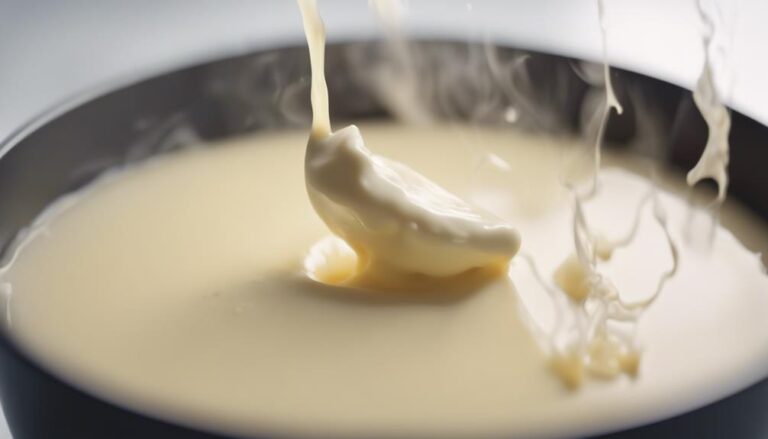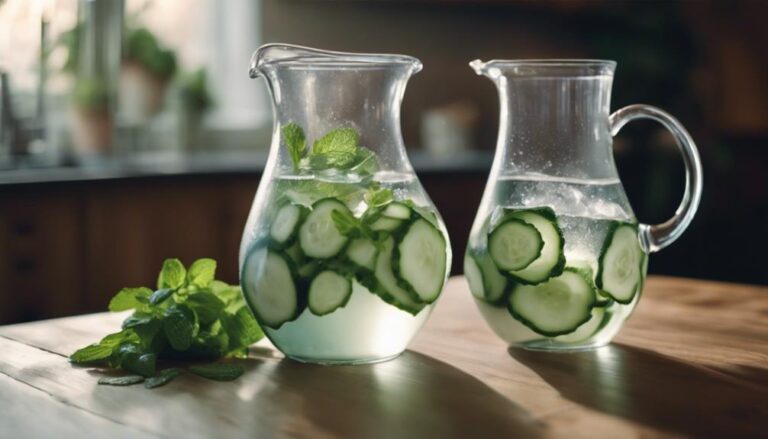Sous Vide Beef Tenderloin With Horseradish Cream
Discover the tender perfection of Sous Vide Beef Tenderloin With Horseradish Cream. Elevate your culinary skills by sealing the beef in a bag and cooking it precisely submerged in water. The horseradish cream adds a zesty kick that complements the richness of the meat flawlessly. Achieve the ideal level of doneness with a juicy texture that will leave you craving more. Experiment with different seasonings to tailor the dish to your preferences. This combination of succulent meat and flavorful cream is a surefire way to impress your guests and your taste buds. Learn the secrets to this exquisite meal.
What You Will Learn Here
- Sous vide cooking ensures perfectly tender beef tenderloin.
- Horseradish cream enhances the dish's flavor profile.
- Searing after sous vide adds depth and richness.
- Experiment with seasonings to personalize the dish.
- Achieve precise doneness with sous vide technology.
Sous Vide Origins
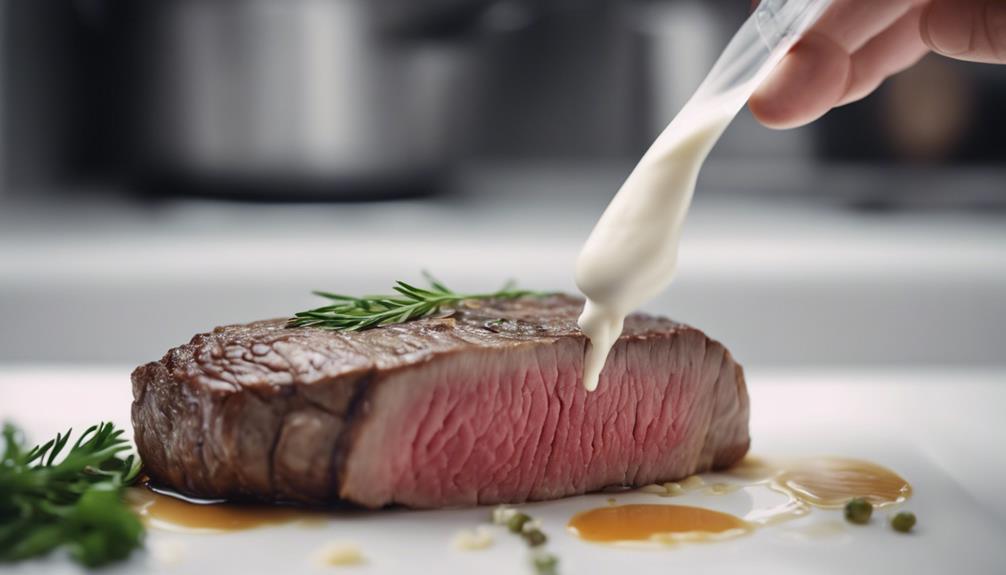
You're about to uncover the fascinating origins of sous vide cooking, a method that revolutionized culinary precision.
Originating in the 1970s in France, sous vide was first used to cook foie gras to perfection. Credited to Chef Georges Pralus, this technique has since evolved into a popular choice for both professional chefs and home cooks alike.
Sous Vide Cooking Method
Originating in the 1970s as a technique pioneered in French restaurants to consistently cook foie gras, the sous vide cooking method revolutionized the culinary world with its precise temperature control and unparalleled results.
This cooking method involves sealing food in a bag, then cooking it submerged in water at precise temperatures. Immersion circulators such as the Anova Precision Cooker are popular tools for maintaining these exact temperatures.
Sous vide guarantees proteins are perfectly cooked, making dishes like beef tenderloin with horseradish cream tender and flavorful. Its ability to minimize the risk of overcooking while infusing rich flavors has made sous vide a favorite among home cooks and professional chefs alike.
Historical Background
Georges Pralus, a French chef in the 1970s, developed the sous vide cooking method, initially using it to enhance the texture and flavor of foie gras. This innovative technique involves sealing food in airtight bags and cooking it in a water bath at precise temperatures, ensuring consistent results and ideal flavor preservation.
Sous vide quickly gained traction in professional kitchens for its ability to retain moisture and deliver dishes with unparalleled precision. Over time, the accessibility of home sous vide machines has democratized this once-exclusive method, allowing home cooks to achieve restaurant-quality results in the comfort of their kitchens.
The historical background of sous vide showcases its evolution from a niche culinary practice to a versatile cooking technique embraced by chefs and food enthusiasts worldwide.
Modern Applications
With its roots in the innovative culinary landscape of the 1970s, sous vide cooking has transcended its origins to become a versatile technique embraced by chefs and food enthusiasts worldwide.
The method, pioneered by French Chef Georges Pralus, revolutionized cooking by introducing precise temperature control through vacuum-sealed bags. This technique guarantees consistent cooking results, making it a favorite among professionals and home cooks alike.
In modern culinary applications, sous vide has found a place in kitchens for its ability to deliver perfectly cooked dishes with minimal effort. The adaptation of immersion circulators and water bath setups for home use has further popularized sous vide cooking, allowing for restaurant-quality meals to be prepared in the comfort of one's kitchen.
Beef Tenderloin Marinade Options
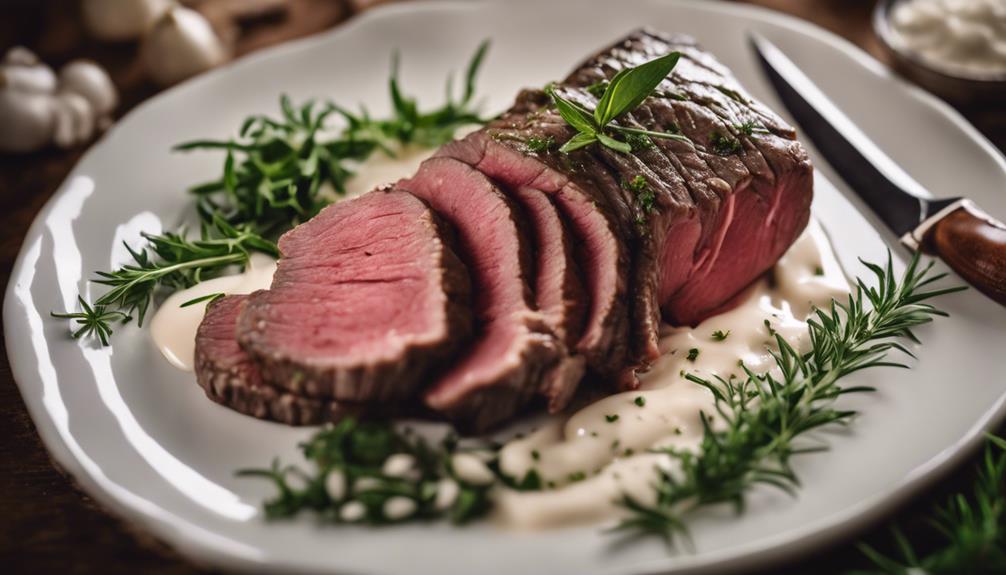
For an additional punch of flavor and tenderness, consider marinating your beef tenderloin with a combination of soy sauce, garlic, herbs, and red wine. Marination is an essential step in the sous vide cooking process, as it helps infuse the beef tenderloin with savory flavors and enhances its juiciness.
Here are some popular marinade options to elevate your beef tenderloin:
- Balsamic Vinegar: Adds a tangy sweetness that complements the richness of the beef.
- Dijon Mustard: Provides a subtle heat and depth of flavor that pairs well with the tenderloin.
- Worcestershire Sauce: Offers a savory umami kick that enhances the overall taste profile of the beef.
- Herb and Garlic Infusion: A classic combination that adds aromatic notes and a robust taste to the tenderloin.
Experimenting with different marinade combinations allows you to cater to various taste preferences, ensuring a delightful dining experience for you and your guests. So, don't hesitate to get creative with your beef tenderloin marinades to create a dish that's truly memorable.
Sous Vide Beef Tenderloin Variations
When it comes to sous vide beef tenderloin variations, you have a world of options to explore. From determining the ideal sous vide filet mignon temperature to experimenting with sous vide ribeye steak, the possibilities are endless.
Don't forget to elevate your dish by considering a horseradish cream pairing for that extra kick of flavor.
Sous Vide Filet Mignon Temperature
Achieving the perfect rare to medium-rare doneness for your sous vide filet mignon at 125°F for 3 hours guarantees a tender and juicy result with consistent precision.
When considering the sous vide filet mignon temperature, the following points are essential to keep in mind:
- Cooking at 125°F guarantees even cooking, preserving tenderness and juiciness.
- Precise temperature control with sous vide leads to a perfectly cooked filet mignon every time.
- A quick sear in a hot skillet after sous vide enhances flavor with a delightful crust.
- Sous vide minimizes the risk of overcooking, delivering a melt-in-your-mouth texture ideal for filet mignon lovers.
Sous Vide Ribeye Steak
Sous vide ribeye steak offers a delightful alternative to explore the richness and marbling of beef tenderloin through a flavorful cooking method. When cooking ribeye steak sous vide, you can expect a juicy and tender texture that perfectly complements its rich flavor profile.
The versatility of sous vide cooking allows you to achieve your preferred level of doneness, whether you enjoy your steak rare, medium-rare, medium, or well-done.
Pairing sous vide ribeye steak with horseradish cream enhances its taste by adding a tangy and creamy element to each bite. Experimenting with different seasonings, sauces, and side dishes can elevate the flavor profile of this classic dish, making it a delicious and satisfying meal option.
Horseradish Cream Pairing
For an exquisite dining experience with sous vide beef tenderloin, exploring the savory pairing of horseradish cream adds a delightful tangy and spicy contrast to the dish.
- Enhancing Flavor: The creamy horseradish sauce made with fresh horseradish and lemon juice elevates the taste of the beef tenderloin.
- Complementing Richness: The zesty and creamy texture of the horseradish cream complements the richness of the sous vide beef tenderloin roast perfectly.
- Versatile Condiment: Beyond beef, this sauce can also enhance the flavors of roast beef, sandwiches, and even seafood dishes.
- Perfect for Special Occasions: The combination of sous vide beef tenderloin and horseradish cream creates a sophisticated and mouth-watering dish ideal for special celebrations.
Searing for Added Flavor
When it comes to searing your sous vide beef tenderloin, it's all about revealing those rich flavors.
The Maillard reaction that occurs during searing is like a symphony for your taste buds, enhancing the overall dining experience.
Mastering different searing techniques can elevate your beef tenderloin from good to exceptional in just a few moments.
Importance of Searing
Enhancing the flavor profile of your sous vide beef tenderloin hinges on the crucial step of expertly searing the meat to create a delectable crust. Searing at high heat triggers the Maillard reaction, which not only enhances taste but also adds visual appeal to your dish. This process locks in the juices, ensuring a succulent and tender texture with each bite. The flavorful crust that forms on the exterior of the beef tenderloin complements the sous vide cooking method, providing a contrast in textures that elevates the overall dining experience. By searing your beef tenderloin properly, you're not just adding a layer of taste; you're building a foundation of complexity and depth that will leave your guests impressed.
| Searing Benefits | Description |
|---|---|
| Flavorful Crust | Searing creates a caramelized outer layer that enhances taste and texture. |
| Maillard Reaction | The reaction between amino acids and sugars at high heat results in a depth of flavor. |
| Locks in Juices | Proper searing helps retain the meat's natural juices, ensuring a moist and tender outcome. |
| Texture Enhancement | Searing adds a crispy exterior to the beef, providing a delightful contrast in textures. |
Enhancing Taste With Sear
Searing your sous vide beef tenderloin not only enhances its flavor but also creates a delightful contrast in textures that elevate the dining experience.
The Maillard reaction that occurs during searing is what brings that rich, savory taste and beautiful brown color to the surface of the beef tenderloin. By searing at high heat, you can achieve a flavorful crust that adds depth to each bite.
Remember to pat dry your beef tenderloin before searing to guarantee proper caramelization and avoid steaming the meat.
Not only does searing enhance the taste, but it also plays a significant role in visually enhancing the presentation of your dish, making it even more appealing to serve.
Searing Techniques for Flavor
After achieving the perfect tenderness with sous vide cooking, the next step in elevating your beef tenderloin's flavor profile is mastering the art of searing for added depth and richness. Searing your beef tenderloin post sous vide not only creates a flavorful crust on the outside but also enhances its taste and texture through the Maillard reaction. To achieve this, sear at high heat for a short time to caramelize the surface without overcooking the interior. Properly searing your beef tenderloin complements the tenderness achieved through sous vide cooking, adding color, depth of flavor, and visual appeal. Below is a table outlining the key points of searing techniques for flavor:
| Key Points | Description |
|---|---|
| Flavorful Crust | Searing post sous vide creates a delicious crust on the beef tenderloin. |
| Maillard Reaction | Enhances taste and texture, adding complexity to the overall flavor profile. |
| High Heat Caramelization | Quick sear at high heat caramelizes the surface without overcooking the meat. |
| Complements Tenderness | Proper searing enhances tenderness achieved through sous vide cooking. |
Final Thoughts
In conclusion, pairing sous vide beef tenderloin with horseradish cream creates a harmonious blend of flavors that will impress even the most discerning of palates. The luxurious tenderness of the beef tenderloin, achieved through the precise sous vide cooking method, is elevated to new heights by the zesty and creamy horseradish sauce. The tangy flavor of the horseradish cuts through the richness of the meat, creating a perfect balance that tantalizes the taste buds. This gourmet dish isn't only a feast for the senses but also a showstopper at special occasions and dinner parties.
The horseradish cream, with its bold and distinct taste, adds a layer of complexity to the dish, making each bite a delightful experience. The creamy texture of the sauce complements the melt-in-your-mouth beef tenderloin, creating a symphony of flavors that will leave your guests in awe. Whether you're hosting a formal dinner or a casual gathering, serving sous vide beef tenderloin with horseradish cream is sure to make a lasting impression on all who indulge in this culinary masterpiece.
Frequently Asked Questions
What Is the Best Temperature for Sous Vide Beef Tenderloin?
For tenderloin cuts like beef, maintaining precise temperature control is key in sous vide cooking. Achieving the ideal doneness level, from rare to medium-rare, guarantees meat tenderness. Sous vide results in consistent, juicy outcomes every time.
What Is Creamy Horseradish Sauce Made Of?
Creamy horseradish sauce is made of grated horseradish variations mixed with sour cream, mayonnaise, and vinegar. The spicy roots provide a kick, while creamy textures balance the flavors. This versatile condiment enhances dishes like beef, pork, seafood, and vegetables.
Which Cooking Method Is Best for Beef Tenderloin?
For beef tenderloin, sous vide is your top choice. It guarantees even cooking, preserving tenderness and juiciness. Sear after for a perfect crust. Grill, oven roast, pan sear, slow cook, high or low heat – sous vide shines.
What Meat Goes With Horseradish?
When it comes to pairing horseradish, think of pork roast, roast beef, prime rib, grilled chicken, smoked salmon, roasted lamb, seared tuna, or BBQ ribs. The zesty kick of horseradish complements these meats perfectly for a flavorful experience.
Conclusion
Indulge in the succulent tenderness of sous vide beef tenderloin with horseradish cream. The precise cooking method guarantees a perfectly cooked piece of meat every time, while the horseradish cream adds a zesty kick of flavor.
Whether you prefer a classic marinade or want to experiment with different variations, this dish is sure to impress your taste buds.
Don't forget to sear for that extra depth of flavor before serving up this delectable meal.
Bon appétit!
